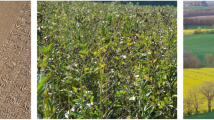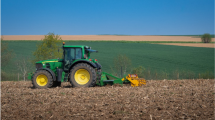Loss of heather has occurred as a result of overgrazing by sheep. There is a clear need to develop grazing management protocols to sustain heather.
Most areas of heather moorland contain a mosaic of four or more vegetation types, with the precise proportion by area of each vegetation type as well as patch size, shape and distribution being unique to each moor. The vegetation types differ in their dry matter production, feeding value and attractiveness to grazing sheep and other herbivores.
The unique nature of the vegetation mosaic on each moor has important consequences for management. In the case of sheep farming, both the impact of the animals on the vegetation and the carrying capacity of a moor for sheep production will vary depending on the vegetational composition. The prescription of a single stocking rate for use on all grazing units containing heather is not sensible in these circumstances.
Our knowledge and understanding of the biology of the moorland grazing system, however, has reached the stage where information on the productivity and feeding value of the various vegetation types and on foraging behaviour and diet selection of the sheep is sufficient to build computer models. These models allow examination of different management options.
An early model currently allows the determination of the upper limits to stock numbers for year-round grazing systems on particular moors if damage to heather is to be avoided.
A more complex model is being developed which will allow examination of the effects of different seasonal patterns and levels of stocking on the offtake levels from the various vegetation types on a particular moor, and on the quality and quantity of the sheep's diet. This model is still being developed and validated, but it provides a promising tool with which to explore management options. Extension of the latter model to include other species of grazer and the effect of different patterns of vegetation is needed to develop multiple land-use models or prescriptions to obtain the optimum biological and economic balance.
Similar content being viewed by others
References
Anderson, P. and Yalden, D.W. (1981) Increased sheep numbers and the loss of heather moorland in the Peak District, England. Biol. Cons. 20, 195–213.
Armstrong, H. (1990) Modelling the effects of vertebrate herbivore populations on heather moorland vegetation. In Modelling Heather Management (M., Whitby and S., Grant, eds), pp. 56–67. Newcastle: University of Newcastle.
Bibby, C.J. (1988) Impacts of agriculture on upland birds. In Ecological Change in the Uplands (M.B., Usher and D.B.A., Thompson, eds), pp. 223–36. British Ecological Society Special Publications Series No. 7. Oxford: Blackwell.
Chapman, S.B., Hibble, J. and Rafarel, C.R. (1975) Net aerial production by Calluna vulgaris on lowland heath in Britain. J. Ecol. 63, 233–58.
Charles, W.N., McCowan, D. and East, K. (1977) Selection of upland swards by red deer (Cervus elaphus L.) on Rhum. J. Appl. Ecol. 14, 55–64.
Coulson, J.C. and Butterfield, J.E.L. (1990) The invertebrate communities of peat and upland grasslands in the North of England and some conservation implications. Biol. Cons. 34, 197–225.
Doyle, C.J. and Lazenby, A. (1984) The effect of stocking rate and fertilizer usage on income variability for dairy farms in England and Wales. Grass Forage Sci. 39, 117–27.
Evans, W.C., Patel, M.C. and Koo, H.Y. (1982) Acute bracken poisoning in monogastric and ruminant animals. Proc. Royal Soc. Edin. 81b, 29–64.
Gordon, I.J. (1989a) Vegetation community selection by ungulates on the isle of Rhum. I. Food supply. J. Appl. Ecol. 26, 35–51.
Gordon, I.J. (1989b) Vegetation community selection by ungulates on the isle of Rhum. II. Vegetation community selection. J. Appl. Ecol. 26, 53–64.
Gordon, I.J. (1989c) Vegetation community selection by ungulates on the isle of Rhum. III. Determinants of vegetation community selection. J. Appl. Ecol. 26, 65–79.
Grant, S.A. (1971) Interactions of grazing and burning on heather moors. II. Effects on primary production and level of utilization. J. Brit. Grass. Soc. 26, 173–81.
Grant, S.A. and Hunter, R.F. (1968) Interactions of grazing and burning on heather moors and their implications in heather management. J. Brit. Grass. Soc. 23, 285–93.
Grant, S.A., Barthram, G.T., Lamb, W.I.C. and Milne, J.A. (1978) Effect of season and level of grazing on the utilisation of heather by sheep. I. Responses of the sward. J. Brit. Grass. Soc. 33, 289–300.
Grant, S.A., Milne, J.A., Barthram, G.T. and Souter, W.G. (1982) Effects of season and level of grazing on the utilisation of heather by sheep. III. Longer-term responses and sward recovery. Grass Forage Sci. 37, 311–20.
Grant, S.A., Suckling, D.E., Smith, H.K., Torvell, L., Forbes, T.D.A. and Hodgson, J. (1985) Comparative studies of diet selection by sheep and cattle: the hill grasslands. J. Ecol. 73, 987–1004.
Grant, S.A., Torvell, L., Smith, H.K., Suckling, D.E., Forbes, T.D.A. and Hodgson, J. (1987) Comparative studies of diet selection by sheep and cattle: blanket bog and heather moor. J. Ecol. 75, 947–60.
Hannam, D.A.R. (1986) Bracken poisoning in farm animals with special reference to the North York Moors. In Bracken: Ecology, Land Use and Control Technology. Proceedings of the International Conference-Bracken, 1985. (R.T., Smith and J.A., Taylor, eds), pp. 133–8. Carnforth, Lancs.: Parthenon Press.
Hewson, R. (1989) Grazing preferences of mountain hares on heather moorland and hill pastures. J. Appl. Ecol. 26, 1–11.
Hodgson, J. and Grant, S.A. (1981) Grazing animals and forage resources in the hills and uplands. In The Effective Use of Forage and Animal Resources in the Hills and Uplands. (J. Frame, ed.), pp. 41–57. Occasional Symposium No. 12, British Grassland Society.
Hodgson, J., Forbes, T.D.A., Armstrong, R.H., Beattie, M.M. and Hunter, E.A. (1991) Comparative studies of the ingestive behaviour and herbage intake of sheep and cattle grazing indigenous hill plant communities. J. Appl. Ecol. 28 (1), 205–27.
Hudson, P.J. (1988) Spatial variations, patterns and management options in upland bird communities. In Ecological Change in the Uplands. (M.B., Usher and D.B.A., Thompson, eds), pp. 381–97. British Ecological Society Special Publications Series No. 7. Oxford: BLackwell.
Hunter, R.F. (1954) The grazing of hill pasture sward types. J. Brit. Grass. Soc. 9, 195–208.
Hunter, R.F. (1962) Hill sheep and their pasture: a study of sheep grazing in south-east Scotland. J. Ecol., 50, 651–80.
Hunting Surveys and Consultants Ltd (1986) Monitoring Landscape Change. London: Department of the Environment and the Countryside Commission.
Job, D.A. and Taylor, J.A. (1978) The production, utilization and management of upland grazings on Plynlimon, Wales. J. Biogeog. 5, 173–91.
Lance, A.N. (1987) Estimating acceptable stocking levels for heather moorland. In Agriculture and Conservation in the Hills and Uplands (M., Bell and R.G.H., Bunce, eds), pp. 109–15. Grange-over-Sands: Institute of Terrestrial Ecology.
Lantinga, E.A. (1986) Seasonal pattern of gross assimilation and net herbage production under continuous stocking. In Grazing. (J., Frame, ed.), pp. 32–8. Occasional Symposium of the British Grassland Society, Hurley: British Grassland Society.
Marsden, J.H. (1989) More sheep and less heather in the Lake District-what should be done. In Grazing Research and Nature Conservation in the Uplands: Proceedings of a Seminar, 1988. (D.B.A., Thompson and K.J., Kirby, eds). Nature Conservancy Council, Research and Survey Series No. 31. Peterborough: Nature Conservancy Council.
Maxwell, T.J., Grant, S.A., Milne, J.A. and Sibbald, A.R. (1986) Systems of sheep production on heather moorland. In Hill Land Symposium, Galway, 1985. (M., O'Toole, ed.), pp. 188–211. Dublin: An Foras Taluntais.
Miller, G.R. and Watson, A. (1978) Heather productivity and its relevance to the regulation of red grouse populations. In Production Ecology of British Moors and Montane Grasslands. (O.W., Heal and D.F., Perkins, eds), pp. 277–85. Berlin: Springer-Verlag.
Miller, G.R., Miles, J. and Heal, O.W. (1984) Moorland management: a study of Exmoor. Cambridge: Natural Environment Research Council, Institute of Terrestrial Ecology.
Milne, J. (1974) The effects of season and age of stand on the nutritive value of heather (Calluna vulgaris L. Hull) to sheep. J. Agricult. Sci. Camb. 83, 281–8.
Milne, J.A. and Grant, S.A. (1987) Sheep management on heather moorland. In Efficient Sheep Production from Grass. (G.E., Pollott, ed.). pp. 165–7. British Grassland Society Occasional Symposium No. 21. Hurley: British Grassland Society.
Milne, J.A., Bagley, L. and Grant, S.A. (1979) Effects of season and level of grazing on the utilisation of heather by sheep. II. Diet selection and intake. Grass Forage Sci. 34, 45–53.
Mohamed, B.F. and Gimingham, C.H. (1970) The morphology of vegetative regeneration in Calluna vulgaris, New. Phytol. 69, 743–50.
Moss, R. and Hudson, P. (1990) Changes in numbers of red grouse. In Modelling Heather Management. (M., Whitby and S., Grant, eds). pp. 9–19. Newcastle: University of Newcastle.
Nature Conservancy Council and Countryside Commission for Scotland (1988) National Countryside Monitoring Scheme. Scotland: Grampian.
Nature Conservancy Council and Countryside Commission for Scotland (1991a) National Countryside Monitoring Scheme. Scotland: Borders.
Nature Conservancy Council and Countryside Commission for Scotland (1991b) National Countryside Monitoring Scheme, Scotland: Lothian.
Pehrson, H. (1981) Winter food consumption and digestibility in caged mountain hares. In Proceedings of the World Lagomorph Conference, Guelph, IUCN, Gland, Switzerland. (K. Myers and C.D. McInnes, eds), pp. 732–42.
Phillips, J. (1990) The case for heather. J. Royal Agr. Soc. England. 151. 96–102.
Putman, R.J., Pratt, R.M., Ekins, J.R. and Edwards, P.J. (1987) Food and feeding behaviour of cattle and ponies in the New Forest, Hampshire. J. Appl. Ecol. 24, 369–80.
Sibbald, A.R. (1990) Biological and economic assessment of potential for sheep production on heather moorland. In Modelling Heather Management (M., Whitby and S., Grant, eds). pp. 28–38. Newcastle: University of Newcastle.
Sibbald, A.R., Grant, S.A., Milne, J.A. and Maxwell, T.J. (1987) Heather moorland management-a model. In Agriculture and Conservation in the Hills and Uplands. (M., Bell, and R.G.H., Bunce, eds), pp. 107–8. Grange-over-Sands: Institute of Terrestrial Ecology.
Sydes, C. and Miller, G.R. (1988) Range management and nature conservation in the British uplands. In Ecological Change in the Uplands. (M.B., Usher and D.B.A., Thompson, eds), pp. 323–37. British Ecological Society Special Publications Series No. 7. Oxford: Blackwell.
Thompson, D.B.A., Marsden, J.H., Mcdonald, A. and Galbraith, C.A. (1993) Upland heather moorland in Great Britain: a review of international importance, vegetation change and some objectives for nature conservation. Biol. Conserv. (in press).
Usher, M.B. and Gardner, S.M. (1988) Animal communities in the uplands: how is naturalness influenced by management? In Ecological Change in the uplands (M.B., Usher and D.B.A., Thompson, eds), pp. 75–92. British Ecological Society Special Publications Series No. 7. Oxford: Blackwell.
Usher, M. and Thompson, D.B.A. (1993) Variation in the upland heathlands of Great Britain: conservation importance. Biol. Conserv. (in press).
Author information
Authors and Affiliations
Rights and permissions
About this article
Cite this article
Grant, S.A., Armstrong, H.M. Grazing ecology and the conservation of heather moorland: the development of models as aids to management. Biodivers Conserv 2, 79–94 (1993). https://doi.org/10.1007/BF00055105
Received:
Revised:
Accepted:
Issue Date:
DOI: https://doi.org/10.1007/BF00055105




